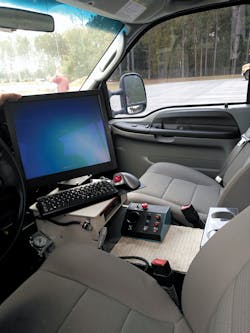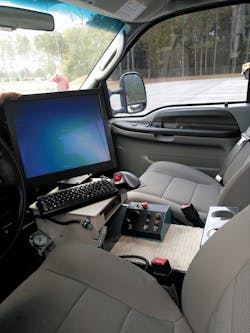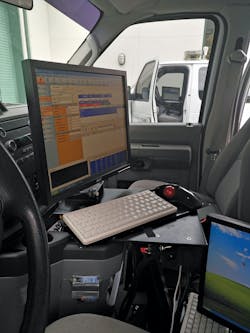Up to the test
Collecting pavement condition and performance data is an essential element of transportation asset management.
Departments of transportation (DOTs) are responsible for driving hundreds of thousands of miles each year for such data collection, using both full-sized survey vehicles that run at highway speeds and site-specific equipment that requires temporary traffic control (TTC) operations. While many safety features have been implemented in the pavement field-testing process, additional safety features that may minimize distractions, enhance pavement testing operators’ (PTOs) awareness of surrounding conditions, and improve mobile or closed TTC operations are still greatly needed.
A team of researchers from the University of South Florida (USF) recently partnered with the Florida Department of Transportation (FDOT) to conduct a study to better understand the risk of PTOs when they measure pavement data in the field, and to investigate methods and technologies that would improve the safety of pavement field testing. Work involved in the study mainly consisted of literature review and questionnaire surveys targeted at pavement engineers in various state DOTs.
The literature review covered information related to the practice of pavement data collection, safety measures of various survey vehicles and TTC operations, and emerging techniques that may improve safety during testing. A variety of literature sources were reviewed, including safety-related reports and manuals from various state DOTs and manufacturers of data collection equipment.
A questionnaire was distributed to at least three pavement engineers in each state DOT to seek input on the need of safety improvement, current safety features, unique safety features in practice, and safety improvement suggestions for pavement field testing both at highway speeds and with TTC operations. A total of 34 responses from 32 state DOTs were received and analyzed.
Based on a review of FDOT safety manuals and plans, and a survey of FDOT PTOs, it was found that the most common reason of incident or accident during pavement field testing is careless or distracted drivers in other vehicles. Lane departure of testing vehicles or personnel during testing is another main factor that may increase accident risk. Methods that can elevate the safety awareness of other drivers, therefore, should be explored, particularly for field tests with TTC operations. For tests at highway speeds, methods that can reduce the multitasking workload of PTOs also are in great need, including more automated data collection software, hands-free operation such as voice-controlled data acquisition, and added vehicle safety features.
Computer mounts for specific vehicle models ensure sufficient proximity of position to the steering wheel; recent studies have found that the computer position generally preferred by an operator is one that is as close to the steering wheel as possible.
A review of safety-related manuals implemented by other state DOTs showed that most manuals describe the safety measures during general testing or data collection processes, particularly for work-zone safety. Most responses from the nationwide survey also suggested paying more attention to the tests within TTC operations, compared to the tests at highway speeds. There are few manuals that provide specific safety strategies for pavement field testing at highway speeds or with mobile operations. One particular aspect analyzed in the review is the number of PTOs required in different field tests. It was found that this number varies from state to state, depending on the safety priority of individual state DOTs, the severity of local PTO-related accidents, various local traffic conditions, and specific field testing technologies. Currently FDOT uses one PTO in most of its pavement field testing at highway speeds. Some state DOTs, however, suggest at least one safety person being involved in the field data collection or field tests. A standard to assign the optimum number of personnel to accomplish a field test or survey safely is yet to be developed, as suggested by Caltrans.
From a review of relevant research and practice reports from various states, it was observed that the use of more advanced and automated equipment is more effective in improving safety for tests at highway speeds, while techniques towards more effective markings, signs and traffic-control measures are more desirable for tests that require TTC operations.
For field tests at highway speeds, however, communications with major vendors of pavement field testing vehicles or equipment revealed that current vendors’ effort to improve their systems is mainly to increase data quality (e.g., accuracy, sampling rate, resolution), not to add new safety features. As short-term solutions, some off-the-shelf products or applications may be added to current survey vehicles for improved safety during testing. Examples include forward-collision and lane-departure warning systems, driver fatigue warning systems, voice recognition applications, and in-vehicle computer-mounting systems.
A forward-collision and lane-departure warning system may help drivers to become more alert to vehicles in front and/or in adjacent lanes. The system detects a leading vehicle and measures the distance from it with the help of a radar detector attached to the front bumper of a facilitated vehicle. Inside the vehicle there is an output unit that can warn the driver visually by changing the color of warning lights and audibly by an alarm. A variety of products in this category are on the market, such as Save Drive System, Mobileye, Delphi and ZFTRW. They can be easily installed on a survey vehicle. Some more advanced systems can not only warn the driver but also brake automatically if the driver does not respond. These systems go by different names such as Forward Collision Warning (FCW), Crash Imminent Brake (CIB) and Emergency Brake Assist (EBA).
A driver-fatigue warning system captures images of the driver with infrared sensors and uses algorithms to judge whether the driver is inattentive due to distraction or drowsiness. There are not many products of this kind available on the market; one, however, is the MR 688 fatigue warning system developed by Care Drive. There still lacks evidence in the literature regarding its effectiveness.
Voice-recognition applications work as an interface between voice commands and keyboard/mouse operations. They can turn any software into voice controllable and can work with any computer software via a simple process. Specific voice commands can be set in the application for specific operations of the intended software. With such applications, a PTO does not need to take his hands off the wheel during testing at highway speeds. A number of voice-recognition applications are available on the market, such as Freesr, Lilyspeech, Braina and Dragon NaturallySpeaking. The research team evaluated the effectiveness of Freesr on a desktop computer and found that it may accurately recognize a user’s voice and commands.
The position of a computer screen in a test vehicle may affect safety, since it will turn the operator’s sight away from roadway traffic conditions when he/she checks information on the screen. Recent studies found that the computer position preferred by an operator is as close as possible to the steering wheel. Computer mounts designed for specific vehicle models are available on the market to ensure sufficient proximity of position to the steering wheel.
Voice-recognition applications can work with any computer software via a simple process; specific voice commands allow a PTO to keep both hands on the wheel during testing at highway speeds.
For field tests that require closed TTC operations, one of the main causes of accidents is a roadway motorist’s failure to notice the test operation. This issue may be addressed by maintaining proper signs and markings around the work zone to increase the awareness of other drivers. In addition, various speed-reduction devices have been developed or tested to provide a rather automatic solution. The devices covered in the review include changeable message signs, speed trailers, portable plastic rumble strips, speed activated displays, radar-activated devices and a movable traffic barrier system. Through assembling these safety devices in different ways, various work-zone safety systems have been proposed or developed in recent years by transportation agencies or research institutes, such as work-zone intrusion warning systems (WIWS), queue warning systems for work zone (QWS), dynamic lane merge systems (DLMS) and variable speed-limit systems (VSLS). Some of the systems have undergone several studies to evaluate their effectiveness while others are still in the conceptual phase.
For field tests that require mobile TTC operations, the same safety devices used for closed TTC operations also may be applied with necessary adjustments. A few state DOTs have suggested or adopted some special methods to alert motorists of slow-moving work vehicles (WVs). For example, the Wisconsin DOT developed a device with two numeric screens (known as “You/Me speed display boards”) mounted on the back of a shadow vehicle (SV) to show the speed of the work vehicle and the speed of oncoming traffic. The Texas DOT suggested providing more detailed information on the display board to motorists, such as using “3 VEHICLE CONVEY” to replace “WORK CONVEY”. The spacing between the SV and the WV is important in reducing the risk associated with public vehicles sneaking in and out between the SV and the WV. Many states follow the Manual on Uniform Traffic Control Devices (MUTCD) to regulate the spacing, which varies according to road type, lane number and other factors, and typically has a minimum value of 100 ft. Recently FDOT revised its design standards to reduce the minimum spacing between the SV and the WV to 50 ft when an advanced warning vehicle is required and operated in the lane behind the SV in urban areas. Since it is difficult to control precise spacing during mobile operations by PTOs and 50-ft spacing sometimes is not safe for heavy vehicle impact at high speeds, this study recommended refining the spacing range for different levels of posted speed limits, with a 50- to 100-ft spacing range limited for a posted speed-limit range of 20-45 mph.
One unique safety measure revealed in the questionnaire survey is the utilization of blue lights with other flashing lights to reduce traffic speed. In Iowa, snow-removal operations have approval to utilize blue lights and white lights in unison with amber lights on snow-removal vehicles. In Nevada, non-flashing high-intensity blue lights are used for vehicle-mounted message/arrow boards. In many other states, however, blue lights are reserved for law enforcement vehicles only. An initiative to change the statutes for allowing blue lights on field-testing vehicles may be proposed.


